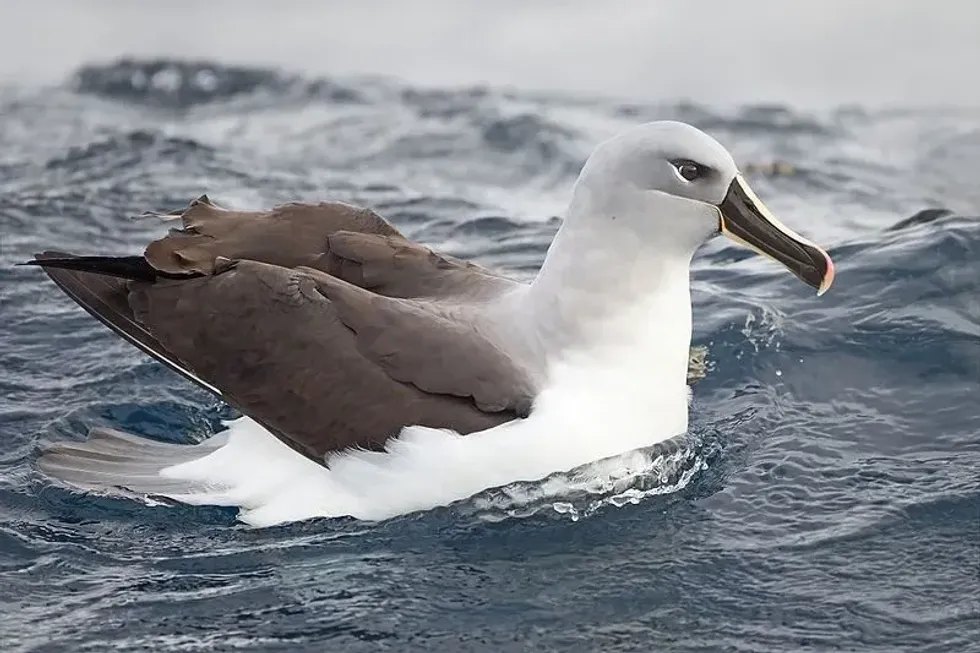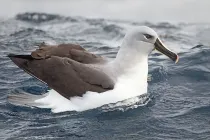Mollymawk (Thalassarche) is also known as albatrosses and gooney birds. It is a medium-sized albatross that belong to the Thalassarche genus.
They belong to the Diomedeidas family and the order Procellariiformes, with shearwaters, fulmars, storm-petrels, and diving-petrels. They share certain identifying features; namely, nasal passages that attach to the upper bill called naricorns, and nostrils on the sides of the bill. Around seven to nine horny plates are split in between the bills of Procellariiformes.
A mollymawk can be found around the tip of the Southern Hemisphere, particularly in the tip of South Africa, South America, New Zealand, and Australia. Previously thought to be of the same as the great albatross, Diomedea, new research about their DNA proves that they are more closely related to the sooty albatross.
If you like these facts about the mollymawk, you may also want to check out these swallow-tailed kite facts and the pelican facts.
Mollymawk Interesting Facts
What type of animal is a mollymawk?
A mollymawk is a group of albatross birds that dwell mostly in the Southern Hemisphere.
What class of animal does a mollymawk belong to?
Mollymawks are a type of albatross that belongs to the bird class.
How many mollymawks are there in the world?
There are no known records of how many mollymawks there are in the world. These albatrosses have subtle differences and pose a challenge for identification. Around 20% of the adults in New Zealand migrate across the Indian Ocean.
Where does a mollymawk live?
Mollymawks are a group of albatross that in live the southern part of the equator, in the vast southern oceans.
What is a mollymawk's habitat?
They can be found in the Southern Hemisphere. You can find different species of these birds in the Antarctic, Indian and Southern Pacific.
They spend most of their time on open seas and oceans, and they have evolved in such a unique way that they can fly for thousands of miles across huge bodies of water. They are so adept at sea that, they can drink saltwater from the oceans.
They have their own desalination system within their bodies, that when they drink salt-water, the salt is separated from the water making it potable for them. They only head to dry land during the breeding season.
Who do mollymawks live with?
An albatross is solitary when in flight. However, pairs nest near each other. They even share a nesting area with other species.
How long does a mollymawk live?
These albatrosses may live up to 60 years.
How do they reproduce?
After months offshore, adults will migrate by pairs to a remote island to breed and nest on the edge of cliffs near water. These birds will sing and dance to initiate breeding.
Procellariiformes are also unique as they only breed with a single partner throughout their life, that is why they are picky. When they find that mate, finally they produce one egg each breeding cycle which happens every year.
The Buller's mollymawk (Thalassarche bulleri) breed in December and lay eggs in January. Incubation of the Buller's mollymawk's egg is around 60 days, with the male and female taking turns.
And each shift is about 10 days. When the eggs hatch, it takes about 170 days for the fledglings to become chicks.
What is their conservation status?
Although you may see them in colonies, these birds are Endangered. They are directly affected by over-fishing. In fact, some species used to be seen in the Northern Hemisphere not so long ago.
Mollymawk Fun Facts
What do mollymawks look like?
These albatross have black backs, mantle, tail, light-colored head, underwings, and bellies. The leading edge of the wing is black.
Their average size is about 35-39 in (90-99 cm) in length, they weigh around 9 lb (4.1kg). It has a whopping wingspan of around 71–101 in (180-256 cm). These albatrosses are believed to have the largest wingspan of any bird in the world, which they use to travel vast distances above open waters.
How cute are they?
Mollymawks are very cute, at first glance, it is easy to mistake them for a duck especially if you see them just chilling around water. Although the nostrils can be found on each side of the Buller's bill.
How do they communicate?
Albatross communicate with each other during the breeding season through singing and dancing. They bounce around, raise and bow their heads.
Followed by bill clacking and rubbing, and lastly when they try to clean each other. However, they also use bill clacking if intruders are coming too close to their nest.
If the intruder doesn’t back off with the bill clacking, it often leads to a violent confrontation where they bite these intruders, and sometimes even vomit at them just to fend them off.
How big is a mollymawk?
A mollymawk is about 35-39 in (90-99 cm) in length and weighs around 9 lb (4.1kg). The length of its massive wingspan around 71–101 in (180-256 cm). They are medium-sized albatrosses.
How fast can a mollymawk fly?
Not only can a mollymawk travel vast distances, but they can also fly really fast. They are able to attain about 80.5 kph (50 mph). They use their massive wings to glide while flying for maximum energy efficiency, that is why the adults during their long flights are able to sleep mid-flight.
How much does a mollymawk weigh?
The average weight of a mollymawk is around 9 lb (4.1kg).
What are the male and female names of the species?
There are no male and female names for a mollymawk. Pairs have been observed to be nesting together with other pairs and other bird species.
What would you call a baby mollymawk?
A baby mollymawk bird is called a chick.
What do they eat?
Their diet mainly revolves around fish, squid, krill, salps, and zooplankton. These birds are excellent at hunting their food. They are one of the few birds that can actually swim and dive just to catch prey.
Stomach oil made up of wax esters and triglycerides provides an energy-rich food source for chicks and adults through a long flight, and to fend off predators as well. Stomach samples were taken at Snares and Chatham Islands from adults and juveniles, all collected by C.J.R. Robertson and A. Wright.
Are they poisonous?
No, they are not poisonous.
Would they make a good pet?
These albatross birds are pelagic and spend most of their time flying around open seas and oceans. They only come to land for breeding so cannot be kept as pets.
Did you know...
Did you know that albatross birds are excellent at fishing? One of the species, specifically the Thalassarche cauta or shy albatross ,was recorded diving in the water while hunting fish at 16 ft (5 m ) deep.
Yes, you read that right. A bird that flies and swims! They were once thought to be the same species as the Salvin's albatross (Thalassarche salvini) and the Chatham albatross.
There are 10 species within this genus, listed below.
(Thalassarche chlororhynchos) Atlantic yellow-nosed albatross: Mid-Atlantic, Tristan da Cunha, Inaccessible Island, Nightingale, Middle, Gough, and Stoltenhoff Island.
(Thalassarche carteri) Indian yellow-nosed albatross: Kerguelen Island, the Crozet Islands, Prince Edward Islands, Southern Africa to the Pacific just after New Zealand, Saint Paul Islands in the Indian Ocean, Amsterdam Island on the French Southern and Antarctic Lands.
(Thalassarche bulleri) Buller’s mollymawk: New Zealand.
(Thalassarche cauta) Shy mollymawk: Austria, Tasmania, and in the southern Indian Ocean.
(Thalassarche steadi) White-capped mollymawk: New Zealand.
(Thalassarche eremita) Chatham albatross: Chatham Islands.
(Thlassarche salvini) Salvin’s albatross: Penguin Island in the Crozet Islands in the Indian and Antarctic Ocean.
(Thalassarche impavida) Campbell albatross: South Island and the Chatham Rise to the Ross Sea.
(Thalassarche chrysostoma) Grey-headed albatross: Southern Georgie in the Southern Atlantic, Diego Ramirez Islands, Kerguelen Islands, Prince Edward Islands, Marion Island, Crozet Islands, Campbell Island, Chile, and Macquarie Island south of New Zealand.
(Thalassarche melanophrys) Black-browed albatross: The Atlantic Ocean, the Cape Horn Islands, Southern Georgia, South Sandwich Islands, and the Falkland Islands.
Are mollymawks Endangered?
Although there are no natural predators of the mollymawks, they are still Endangered. The two main culprits for the decline in their population is contact with commercial fishing boats and plastic debris.
These albatrosses get caught in long lines of fishermen, and sometimes they unknowingly dive in the hunt for food, but get clipped by a hook and trapped. And lastly, they often mistake plastic debris for squid.
In Alaska, fishermen have been using streamer lines. This is relatively cheap and easy to use with high success rates, which is a viable solution to the problem.
They catch fish and keep the albatross away, a win-win situation.
The National Marine Fisheries Services (NMFS) set a rule requiring fishing boats over 55 ft (17 m) to use streamer lines to prevent sea birds from getting caught in their hooks and lines. Because of its effectiveness and sustainability, some Alaskan fishermen even voluntarily use this instead of the old way.
How did mollymawks get their name?
The word mollymawk comes from the Dutch word 'mallemok'. The word 'mal' means foolish and 'mok' means gull.
Another source is suggesting that it came from the German word 'mallemuge', a term used for flies rapidly moving around lights. Although the birds of the genus Phoebetria are usually called sooty albatrosses, they are sometimes referred to as 'mollymawk' as well.
Here at Kidadl, we have carefully created lots of interesting family-friendly animal facts for everyone to discover! For more relatable content, check out these common blackbird facts and blue-winged teal facts pages.
You can even occupy yourself at home by coloring in one of our free printable Mollymawk coloring pages.










